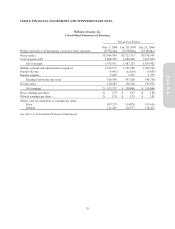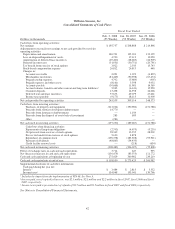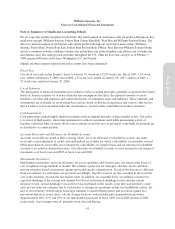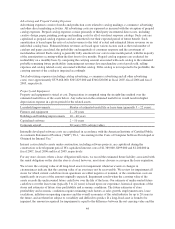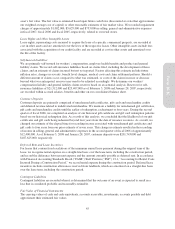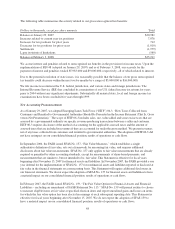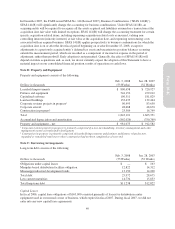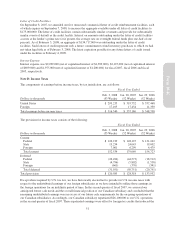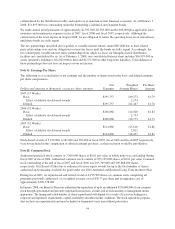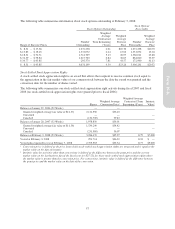Pottery Barn 2007 Annual Report Download - page 57
Download and view the complete annual report
Please find page 57 of the 2007 Pottery Barn annual report below. You can navigate through the pages in the report by either clicking on the pages listed below, or by using the keyword search tool below to find specific information within the annual report.
estimated future volatility of our stock price and the estimated expected term until the option award is exercised
or cancelled. The fair value of the award is amortized over the expected service period. Total stock-based
compensation expense was $26,812,000, $26,759,000 and $440,000 in fiscal 2007, fiscal 2006 and fiscal 2005,
respectively, and is recorded as a component of selling, general and administrative expenses. Prior to fiscal 2006,
we accounted for stock-based compensation arrangements using the intrinsic value method in accordance with
Accounting Principles Board Opinion No. 25, “Accounting for Stock Issued to Employees” and related
interpretations. Accordingly, no compensation expense was recognized prior to fiscal 2006 for option awards
with an exercise price equal to the fair value of our common stock on the date of grant.
Financial Instruments
As of February 3, 2008, we have 15 retail stores in Canada and limited operations in both Europe and Asia, each of
which expose us to market risk associated with foreign currency exchange rate fluctuations. Although these
exchange rate fluctuations have not been material to us in the past, we may enter into foreign currency contracts in
the future to minimize any currency remeasurement risk associated with the intercompany assets and liabilities of
our subsidiaries. We did not enter into any foreign currency contracts during fiscal 2007 or fiscal 2006.
Foreign Currency Translation
We have subsidiaries which have foreign operations and a functional currency different than the U.S. dollar, such
as in Canada (functional currency of the CAD), in Europe (functional currency of the euro), in Turkey (functional
currency of the lira), in the United Kingdom (functional currency of the GBP) and in Vietnam (functional
currency of the dong). Assets and liabilities are translated into U.S. dollars using the current exchange rates in
effect at the balance sheet date, while revenues and expenses are translated at the average exchange rates during
the period. The resulting translation adjustments are recorded as other comprehensive income within
shareholders’ equity. Gains and losses resulting from foreign currency transactions have not been significant and
are included in selling, general and administrative expenses.
Earnings Per Share
Basic earnings per share is computed as net earnings divided by the weighted average number of common shares
outstanding for the period. Diluted earnings per share is computed as net earnings divided by the weighted
average number of common shares outstanding for the period plus common stock equivalents consisting of
shares subject to stock-based awards with exercise prices less than or equal to the average market price of our
common stock for the period, to the extent their inclusion would be dilutive.
Income Taxes
Income taxes are accounted for using the asset and liability method. Under this method, deferred income taxes
arise from temporary differences between the tax basis of assets and liabilities and their reported amounts in the
consolidated financial statements. We record reserves for estimates of probable settlements of foreign and
domestic tax audits. At any one time, many tax years are subject to audit by various taxing jurisdictions. The
results of these audits and negotiations with taxing authorities may affect the ultimate settlement of these issues.
Our effective tax rate in a given financial statement period may be materially impacted by changes in the mix and
level of earnings.
On January 29, 2007, we adopted the provisions of FIN 48, which clarifies the accounting for uncertain tax
positions. As a result of the implementation of FIN 48, we recognized an $11,684,000 increase in unrecognized
tax benefits, which was accounted for as a reduction to the January 29, 2007 balance of retained earnings. As of
February 3, 2008 we had $35,211,000 of unrecognized tax benefits, of which $22,634,000 (net of tax benefit)
would, if recognized, affect the effective tax rate. During fiscal 2007, the adoption of FIN 48 resulted in an
approximate net 40 basis point negative impact on our effective tax rate.
47
Form 10-K




